Common Causes of Drinking Water Pollution
Posted by Kenton Jones on Sep 8th 2021
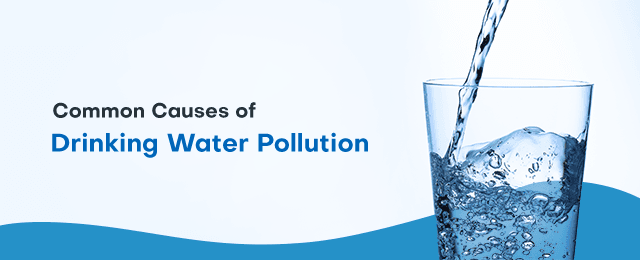
Drinking water is vital for human life. Most people can go for days without food — hunger strikes of
up to 40 days are well documented, some prisoners have lasted for up to 73 days without food, and the longest known fast lasted for over a year, though the person in question did take supplements. But water is a different story entirely. If the human body does not receive hydration, it rapidly begins to shut down. Though different people experience different responses to water deprivation, it's generally true that a person deprived of water would last only about a week or less in harsh conditions.
Having clean water to drink is critical as well. Yet earth's supplies of quality drinking water are diminishing. Water pollution is an accelerating problem — a staggering
80% of the world's wastewater, for example, is currently dumped back into the fresh water supply without undergoing treatment first. Every year, unclean water makes a billion people ill and kills 1.8 million.
Fortunately, we can take steps to help address the issue of drinking water pollution. Below, we'll discuss what water pollution is, lay out some common water pollutants and their sources, and talk about what individuals can do to help prevent water pollution and keep themselves safe and healthy.
What Is Water Pollution?
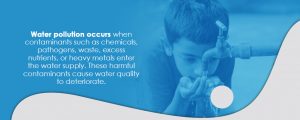
Water pollution occurs when contaminants such as chemicals, pathogens, waste, excess nutrients, or heavy metals enter the water supply. These harmful contaminants cause water quality to deteriorate. They might merely give the water an unpleasant taste or smell, or they might make it toxic to drink or swim in.
Water pollution generally has two types — point pollution and nonpoint pollution. Point pollution comes from a single source, such as when a factory discharges contaminated water directly into a waterway. Nonpoint pollution comes from several different sources, such as when floodwaters sweep over the land and pick up contaminants from different farms or factories. There's also transboundary pollution, which occurs when water pollution from one nation spills across its border into another.
Water pollution can affect both surface water and groundwater, making both types of water sources unsafe to drink.
Surface Water Pollution
Surface water is the water that covers the majority of the earth's surface — our oceans, rivers, lakes, ponds, and streams. Surface water from freshwater sources like rivers and lakes makes up the source for about
61% of the water Americans use in their homes. But the Environmental Protection Agency (EPA) estimates that a troubling 46% of U.S. rivers and streams are too polluted for humans to use as safe sources of water or even for recreation.
Groundwater Pollution
Groundwater collects when precipitation seeps beneath the earth's surface and gathers in an aquifer — a natural, underground water repository. The remaining 40% or so of Americans who do not get their water from surface water get it from groundwater, often from wells. Groundwater is particularly
sensitive to contamination by chemical runoff, which can render an aquifer unsuitable for use for decades, even millennia.
Main Causes of Water Pollution
A few main factors contribute to water pollution and contaminated drinking water.
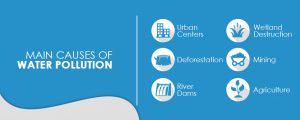
Urban Centers
Urban centers produce thousands of gallons of wastewater every day. In the United States, wastewater receives treatment before being released, but if the wastewater is not thoroughly treated, it can still release contaminants — including harmful pathogens — into the water supply. Faulty septic systems, leaking sewer lines, leaking landfills, lawn chemicals, pesticides, pet waste, and household cleaners can also contaminate the water near urban areas, either through runoff or through direct dumping into waterways.
Industrial waste from factories or processing plants near urban centers also causes water pollution. Factories use and produce many toxic substances — lead, nitrates, asbestos, sulfur, and more — and when they dump their wastewater into lakes or rivers, water pollution is the result. Industrial runoff can also lead to an overgrowth of nutrients such as sulfites, nitrates, and phosphates — an overgrowth known as eutrophication — and promote the formation of toxic algae blooms, which can diminish oxygen levels and choke out other aquatic plant and animal life. Some of these blooms produce neurotoxins that are fatal to wildlife.
And growing urban centers are usually home to construction projects. These projects often involve residential or commercial buildings, or they might involve infrastructure projects such as the construction of new roads or bridges. Either way, chemical solvents and other pollutants and debris can easily wash from urban construction sites and into the water supply.
Deforestation
Deforestation causes soil erosion because of the loss of tree root systems that would otherwise hold the soil in place. Soil erosion can also lead to water pollution if the ground contains contaminants like household chemicals or pesticides. The chemicals enter rivers, lakes, and streams and end up in our water supply, along with harming local plants and wildlife.
Even if the soil that washes into water contains no harmful chemicals, sedimentation itself can pollute the water supply. Too much sediment in the water decreases the amount of sunlight and oxygen available to aquatic species like fish. It can also kill fish larvae and collect in fish gills, ultimately leading to the death of the adult fish as well.
A recent paper published by the Proceedings of the National Academy of Sciences studied deforestation and its effect on access to clean water in Malawi, which has the highest deforestation rate in sub-Saharan Africa. The researchers found that a 1% increase in deforestation led to a
corresponding 0.93% decrease in access to clean drinking water. A recent 14% increase in deforestation in Malawi led to a clean-water scarcity similar to the scarcity that would occur with a 9% decrease in rainfall across the country. And similar effects are evident around the world.
River Dams
According to the EPA, dams can cause increased water pollution. Of course, a river dam causes water to back up and accumulate — and if the water contains sediment or chemical contaminants, those contaminants back up and accumulate as well.
Dam construction can also lead to soil erosion and increased sedimentation of the river. The EPA recommends a
three-part strategy to combat soil erosion—developing a plan to create as little soil disturbance as possible, diverting and creating barriers to runoff, and using sediment-capturing devices to keep sediment from washing away downriver. Using local vegetation as a barrier to runoff and sediment loss, such as with vegetative buffers and geogrids, is often part of an effective strategy. Tools and techniques such as bank shaping, branch packing, brush layering, runoff intercepts, retaining walls, sediment fences, and tree armoring are helpful as well.
Debris from construction or chemicals like adhesives used in the building of the dam may also wash into the river and flow toward residential faucets and showerheads. Construction managers on a new dam site should take care to keep these contaminants contained.
Wetland Destruction
When left undisturbed, wetlands act as a
natural water filter. In the wetlands, plants' roots usually grow submerged in water, so the plants can take in some harmful substances and keep them out of the environment — much as plants take in carbon dioxide, use it for respiration, and give off oxygen as a byproduct. Wetlands also act as a buffer against storms and erosion.
But as human habitation encroaches on wetlands, wetland areas diminish, and their filtering and buffering capabilities diminish as well. Wetland destruction leads to erosion and more significant flooding runoff, both of which can spread contaminants far across the surrounding land. And a smaller area of wetlands can filter a much smaller volume of pollutants out of our environment.
Wetland destruction often happens to make room for human construction, and construction sites typically contain solvents, adhesives, and other chemicals that run off and contaminate nearby waterways. If wetlands are destroyed to make way for oil refineries or pipelines, the risk of oil leakage and water contamination is also incredibly high.
Mining
Mines increase the quantity of minerals and salts in the environment and produce contaminating byproducts such as metallic waste. These toxic byproducts easily wash away in the rain or leach into the groundwater. Either way, they soon end up in our water supply.
Too much sodium in drinking water can be harmful to people with certain heart conditions. And boron, which is beneficial to plant life in small amounts, can be lethal for plants at higher concentrations.
Runoff from mines can also change the pH of the surrounding water, making it either more acidic or more basic. An excessive concentration of iron in water, for example, causes acidification and also lends the water a reddish color. It can stain a home's pipes and bathroom fixtures and even discolor fabrics in the laundry. Acidic water can easily corrode a home's plumbing, and basic water forms unsightly scale deposits.
Agriculture
Agricultural runoff is a tremendous cause of water pollution — it is the
leading cause of compromised water quality in the United States. Most nonorganic farms use chemical fertilizers and pesticides to increase their yields. But these fertilizers and pesticides can run off with spring rains or flooding and flow into the water supply.
Improper irrigation practices can also lead to contaminated runoff. The evaporation of irrigation water can lead to a high concentration of salts, and irrigation runoff often contains pesticides, fertilizers, and heavy metals.
Additionally, agricultural fertilizers often contain nitrogen, potassium, and phosphorus. These elements — nitrogen in particular – are some of the primary causes of the eutrophication process mentioned above. Nitrogen in water turns into nitrates, and nitrates can cause human health problems if consumed. Infants, in particular, are susceptible to a disease called methemoglobinemia — known colloquially as "blue baby syndrome" — which reduces oxygen in the blood to dangerously low levels. High levels of nitrates can also lead to a toxic overgrowth of algae in lakes and rivers.
Agricultural operations are also sources of animal waste. Particularly in feedlots, where pigs, sheep, or cattle crowd into one place to consume food, animal waste collects in concentrated amounts. According to the EPA, 238,000 U.S. ranches and farms are classified as feeding operations, and they generate
500 million tons of manure annually. If runoff carries this waste into the water supply, it can introduce harmful viral and bacterial pathogens such as cholera, giardia, and E. coli. Farmers can help address this issue by storing or process waste where it cannot leak into groundwater or run off into streams and rivers.
Even livestock grazing can lead to water contamination. Overgrazing depletes the natural root system that helps hold soil in place. When this happens, the eroded soil washes into the water supply. This soil erosion can introduce herbicides, pesticides, and fertilizers into the water supply and pollute it so that it becomes unsafe to drink.
Leakage From Underground Storage and Piping
One of the all-too-common causes of water pollution is leaks from fuel storage and transport. As companies transport liquid petroleum products through underground pipelines, environmentally devastating leaks may occur at any point of the journey.
The Keystone Pipeline oil leak of 2019, which spilled
more than 378,000 gallons of crude oil into North Dakota, is just one notorious example of these leaks. Though it did not affect drinking water quality because the spill area was not a drinking water source, it sent contaminants flooding into North Dakota's wetlands, leaving residues that will likely linger for years to come. A similar leak near a water source could contaminate drinking water for thousands of people.
Corrosion or repeated use can also damage underground storage containers (UST), allowing contaminants to cause soil and groundwater pollution. One pinprick-sized hole in a UST can
discharge up to 400 gallons of fuel a year, and a single gallon of leaked petroleum can contaminate up to 1 million gallons of water.
Effects of Water Pollution
Water pollution has highly detrimental effects on human health and the environment. Let's take a closer look at some of the damage it can cause.
Human Health Effects
Illnesses such as giardia, cholera, hepatitis A, Legionnaire's disease, schistosomiasis, and typhoid often spread through contaminated drinking water. Many of these illnesses cause gastrointestinal symptoms, some severe. Globally, contaminated drinking water
causes 485,000 diarrhea-related deaths every year.
In the United States,
about 7.2 million people become sick every year because of contaminants in their drinking water. For example, the EPA reports that between 8,000 and 18,000 people per year become hospitalized from Legionnaire's disease, a respiratory infection caused by contaminated aerosols in piped water systems.
The adverse health effects of water pollution
often disproportionately affect lower-income communities, as well. Sources of water pollution are more likely to be located close to their homes, and these communities often have aging water infrastructures.
Environmental Effects
Contaminated water has devastating effects on the environment. A small change in water quality can have ripple effects through an entire complex ecosystem, affecting everything from tiny microorganisms to algae and plants to fish and wildlife.
One common environmental result of nutrient pollution in water sources is algal overgrowth. When agricultural pollution sends excess nutrients running off into the water supply, algae thrive on them and begin to proliferate. They consume most of the oxygen in the water, choking out fish and other aquatic species. Some algae also
produce neurotoxins that can be deadly even for large species like sea turtles and whales.
Contaminants from municipal and industrial wastewater are harmful to the environment, as well. Wastewater often contains heavy metals and chemicals that are toxic to plants and animals. They may also interfere with reproductive abilities. Studies have found that improper disposal of hormonal birth control — flushing it into the water supply — can
diminish reproductive capacity in fish, for example. Alternatively, they may sicken or kill wildlife, reducing biodiversity and leaving a contaminated habitat behind.
Pollutants like pharmaceuticals, chemicals, and heavy metals like mercury often make their fatal way up the food chain, accumulating in the bodies of large predators like eagles with every small fish they eat.
How Can I Help Prevent Water Contamination?
Water contamination is a serious issue, but every little bit of prevention helps, even at home. You can help prevent water contamination by taking some of these simple steps:
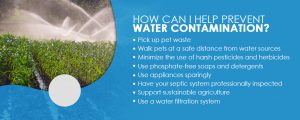
- Pick up pet waste: Picking up pet waste helps guard against the transmission of bacteria and viruses into the water supply.
- Walk pets at a safe distance from water sources: Try to walk your pets in grassy or wooded areas rather than along riverbanks or near ponds. That way, even if pets' waste transmits harmful pathogens into the ground, they won't contaminate sources of drinking water.
- Minimize the use of harsh pesticides and herbicides: Try to use natural, nontoxic methods instead, such as growing plants that insects avoid or minimizing the accumulation of pest food sources.
- Use phosphate-free soaps and detergents: Using phosphate-free soaps and detergents helps keep an overabundance of nutrients from leading to algae blooms in our water supply.
- Use appliances sparingly: Making efficient use of your dishwasher and washing machine is vital. Running these appliances only when they are full means you'll use less detergent, which means fewer contaminants flowing out of your home in your wastewater.
- Have your septic system professionally inspected: A professional inspection helps ensure that your septic system isn't leaking waste into the environment.
- Support sustainable agriculture: If you have local organic farms in your area, buying some of your food from them is a great way to reduce the environmental impact of your consumption. You'll get fresh, locally sourced foods, and you'll know they kept their local water supply free from pesticides and herbicides. Supporting free-range operations where animals are not confined to feedlots also helps protect the water supply from concentrated animal waste.
- Use a water filtration system: Even if you can't prevent all contaminants from getting into the local drinking water, you can still keep your home's water safe and refreshing. A water filtration system helps reduce the number of contaminants in your water so you'll always have great-tasting and healthy water to drink.
Partner With Multipure for Clean Drinking Water
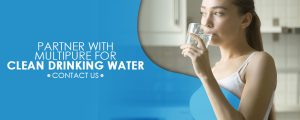
The
serious problem of water pollution is not one to take lightly. To help keep your household safe and healthy — and keep your drinking water tasting and smelling fresh and clean — consider investing in a water filtration system from Multipure.
We offer a variety of different systems to meet every need, from
whole-house filtration systems to specific drinking water systems or showerhead attachments. We even have a filtered water bottle for the convenience of clean water on the go. And our third-party testing means many of our products are certified to perform to the highest standard.
Contact us today to learn more.

